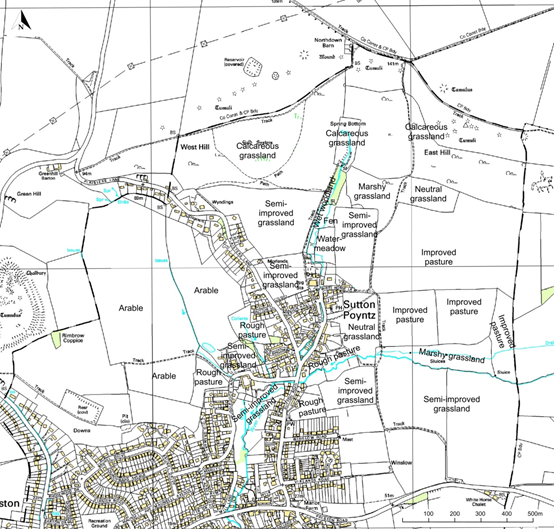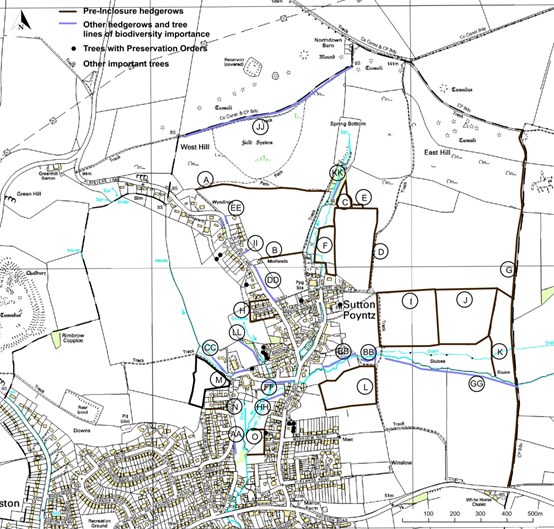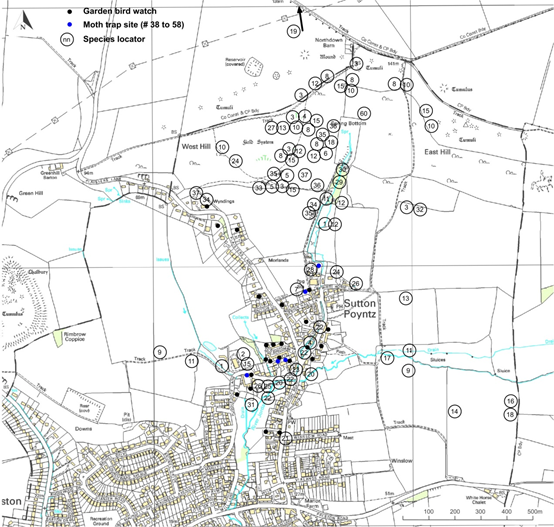
MAPS AND OTHER SUPPORTING INFORMATION RELEVANT TO POLICIES ON BIODIVERSITY AND THE NATURAL ENVIRONMENT
Biodiversity maps
MAP 12 - Land Classification and Priority Habitat Type

| UK NATIONAL BIODIVERSITY ACTION PLAN PRIORITY HABITAT (Habitat identified as being present in the Neighbourhood Plan Area – examples and locations are outlined in the Priority Species report (4) and the Hedgerow survey (3)) |
| Ponds and Running Water |
| Traditional Orchards |
| Wet Woodland |
| Hedgerows and boundary features |
| Neutral grassland – lowland meadows |
| Roadside verges |
| Broadleaved Woodland and Scrub |
| Calcareous Grassland |
| Arable field margins |
| Buildings |
MAP 13 - Important Biodiversity Habitat/Hedgerow Survey

Note: Reference should be made to the hedgerow survey 2017 (3) for a detailed description of each hedgerow and the qualifying features.
MAP 14 - List of Priority Biodiversity Species within the Sutton Poyntz Neighbourhood Plan Area.

This refers to species of cause for concern, in decline or threatened according to the UK National Biodiversity Action Plan (NBAP) 2007 schedule and BoCC 4 Red Data list of birds 2015
The Map reference is colour coded to represent the commonality of local sightings as follows:
Green = Frequently observed each season: Amber = Variable seasonal observations: Red = Occasional seasonal observations. A more detailed description is provided at reference 4 in Section 6 of this document.
| Map ref. | SPECIES |
| BIRDS | |
| 1 | Common Bullfinch Pyrrhula pyrrhula pileata |
| 2 | Common Starling Sturnus vulgaris |
| 3 | Corn Bunting Milibria calandra |
| 4 | Grey Wagtail Motacila cinerea |
| 5 | Grasshopper Warbler Locustella naevia |
| 6 | European Herring Gull Larus argentatus |
| 7 | House Sparrow Paser montanus |
| 8 | Linnet Carduelis canbina |
| 9 | Northern Lapwing Vanellus vanellus |
| 10 | Skylark Aluda arvensis |
| 11 | Song Thrush Turdus philomeios |
| 12 | Spotted Flycatcher Muscicapa striata |
| 13 | Ring Ouzel Turdus torquatus |
| 14 | Whinchat Saxicola rubetra |
| 15 | Yellow Hammer Emberiza citronella |
| 16 | Yellow Wagtail Motalcilla flava flavissima |
| 17 | Redwing Turdus iliacus |
| 18 | Fieldfare Turdus pilaris |
| MAMMALS | |
| 19 | Brown Hare Lepus europaeus |
| 20 | Water Vole Arvicola amphibius |
| 21 | West European Hedgehog Erinaceus europaeus |
| FISH | |
| 22 | European Eel Anguilla anguillus |
| 23 | Brown Trout Salmo trutta |
| HERPTILES | |
| 24 | European Adder Vipera berus |
| 25 | Grass Snake Natrix natrix |
| 26 | Slow worm Anguis fragilis |
| 27 | Common Toad Bufo bufo |
| N/A | Great Crested Newt Triturus cristatus |
| BATS | |
| 28 | Brown Long Eared Plecotus auritus |
| 29 | Barbastelle Barbastella barbastellus |
| 30 | Greater Horseshoe Rhinolophus ferrumequinum |
| 31 | Noctule Noctula nyctalus |
| 32 | Soprano Pipistrelle Pipistrellus pygmaeus |
| BUTTERFLIES | |
| 33 | Dingy Skipper Erynis tages |
| 34 | Grizzled Skipper Purgus malvae |
| 35 | Lulworth Skipper Thymelipus acteon |
| 36 | Small Heath Coenonympha pamphilus |
| 37 | Brown Wall Hasiommata negera |
| MOTHS (at sites marked with a blue dot) | |
| 38 | Blood Vein Timandra comae |
| 39 | Centre Barred Sallow Atethmia centrago |
| 40 | Cinnibar Tyria jacobaeae |
| 41 | Dark-barred Twin-spot Carpet Xanthoroe ferrugata |
| 42 | Dusky Thorn Ennomos fuscantaria |
| 43 | Buff Ermine Spilosoma lubricipeada |
| 44 | White Ermine Spilosoma luteum |
| 45 | Common Fanfoot Pechipogo strigilata |
| 46 | Figure of Eight Diloba caeruleocephala |
| 47 | Garden Tiger Actia caja |
| 48 | Knot Grass Acronicta rumicis |
| 49 | Lackey Malacosoma castrensis |
| 50 | Lunar Yellow Underwing Noctua urbona |
| 51 | Mouse Moth Amphipyra tragopogomis |
| 52 | Mullein Wave Scopula marginepunctata |
| 53 | Oak Hook Tip Watsonalla binaria |
| 54 | Shoulder Striped Wainscot Mythimna comma |
| 55 | Small Emerald Hemistola chrysoprasaria |
| 56 | Small Phoenix Ecliptopera silaceata |
| 57 | Small Square Spot Diarsia rubi |
| 58 | Sword Grass Xylena exsoluta |
| BEETLES | |
| 59 | Violet Oil-beetle Meloe violaceus |
| FLORA | |
| 60 | Eyebright Euphasia sp. |
Acknowledgement: This information has been assembled based upon provision of data from several sources and particular thanks are due to J.N. Newbould, J and S Campbell, D. Emery, C Marsh, R Oxby, J Winsper, Wessex Water and contributors to the Sutton Poyntz Garden Bird Watch Scheme.
| BNE 2.4. Extract from the Lawton Report 2010 (2) ‘Making space for nature’2.2.1 What is an ecological network? Much of England’s wildlife is now restricted to certain places, our wildlife sites, consisting largely of semi-natural habitats moulded by millennia of human-use. These sites are essential for the survival of many plants and animals and will remain important even if the species and habitats within them change. Surviving in small, isolated sites is, however, difficult for many species, and often impossible in the longer term, because they rarely contain the level of resources or the diversity of habitats needed to support sustainable populations. However, an alternative is to designate a suite of high quality sites which collectively contain the range and area of habitats that species require…. and allow species to move between them. It is this network of core sites connected by buffer zones, wildlife corridors and smaller but still wildlife-rich sites that are important in their own right and can also act a ‘stepping stones’ that we call an ecological network. ‘Wildlife corridors’ do not have to be continuous, physical connections: a mosaic of mixed land use, for example, may be all that is needed – it is the permeability of the landscape to species that matters |